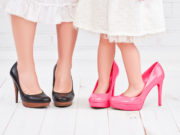High Heels -Foot Biomechanics
Girls, my feet taught me the painful way how not to walk it. I walked to work from Penn Station NYC down to Greenwich Village(a little over a 1 1/2 miles), in my 2 1/2” pumps. My toes hurt, grew blisters, my calves were sobbing, and the bottoms of my feet felt like a taut rubber band. But, why should a pair of heels that were uber comfortable when I left my house, so painfully betray me later that morning, simply by walking? I discovered it all has to do with foot biomechanics.
Biomechanics of the foot, that combination of muscles, bones, tendons and ligaments which are designed to support and ambulate the human body in a specific way. Proper weight distribution relies on the correct positioning and deflection of all those interrelated parts.
The human foot is comprised of 26 bones. These bones are separated into 3 section; Tarsals, Metatarsals, Phalanges. The Calcaneus bone(the heel) makes up the hind foot. It is the largest of the foot bones, and is designed to absorb the bulk of the weight of the body when erect. It also radiates shock, distributing impact upward through the Tibia and Fibula(leg), and outward through the Metatarsals and Phalanges(foot and toes), when in motion.
 The arch, or Vault, of the foot allows for flexion when compressed in natural walking or running composure. The image above illustrates typical walking motion. Inclining the foot in a high heel shoe, reduces the surface area of the arch, as the vertical line, mid-foot line, is compromised. This places additional expectation on the bones of the forefoot and associated structures. Prolonging this plantar flexion angle, affects the biometric action of the foot, resulting in a host
The arch, or Vault, of the foot allows for flexion when compressed in natural walking or running composure. The image above illustrates typical walking motion. Inclining the foot in a high heel shoe, reduces the surface area of the arch, as the vertical line, mid-foot line, is compromised. This places additional expectation on the bones of the forefoot and associated structures. Prolonging this plantar flexion angle, affects the biometric action of the foot, resulting in a host  of ailments.
of ailments.
Angling the foot in heels also throws off weight distribution. When standing erect, or even sitting, the weight is positioned forward to the balls of the foot. The forefoot is not designed to withstand this greater quantity of potential energy for extended periods of time. The added amount of trauma, as a result of shock to the forefoot, transmits back through the bones, ligaments and muscles. This results in muscle strain, ligament and tendon complications, and fatigue.
The force acting on an object is equal the mass of the object multiplied by its acceleration
There is also the complication of heel plantation, and the joys of sinking in the grass. According to Sir Isaac Newton’s 2nd law of motion: “The force acting on an object is equal the mass of the object multiplied by its acceleration.” In the instance of wearing high heels, the Mass of the female body is equal to the Force applied to the heel, divided by the Acceleration of the foot. This full force is applied to approximately a 1/8” circumference total surface area, causing the heel to cut into soft surfaces.
By comparison, an elephant and women in heels exert equal pressure on the heel, approximately 6,000 psi. The elephant doesn’t sink in the ground as a woman does wearing heels, due to the difference in total surface area in contact with the ground. The circumference of elephant’s foot is wider then the circumference of the tip of the high heel, thus distributing the total weight over a larger surface area.
More than 100 muscles, ligaments and tendons bind the 26 bones together. There are 14 tendons, the largest of which is the Achilles Tendon, and 10 ligaments that connect the muscles of the foot. The Plantar Fascia ligament runs laterally under the foot and when injured, causes painful Plantar Fasciitis.
Total foot support is divided between the ball of foot (40% of weight) and heel (60% of weight). Bare feet  have a more equal, 50% ratio between the ball and heel. Wearing a high heel can imbalance the ratio 90% ball of foot, 10% heel. When the foot is perpetually inclined where the ball of the foot supports the bulk of the weight, natural biometric ratios are interrupted. The result is Plantar Flexion is placed out of 0 degree rest position, and can lead to damage of bones, ligaments, and tendons, from decades of continuous inclination.
have a more equal, 50% ratio between the ball and heel. Wearing a high heel can imbalance the ratio 90% ball of foot, 10% heel. When the foot is perpetually inclined where the ball of the foot supports the bulk of the weight, natural biometric ratios are interrupted. The result is Plantar Flexion is placed out of 0 degree rest position, and can lead to damage of bones, ligaments, and tendons, from decades of continuous inclination.
Moderation, as with everything, is the key to having a happy life in your high heels. It is recommended to wear high heels 2-3 times per week. I cannot subscribe to that ideology, however. I had my revelation, and ceded to my girlfriend’s “function over fashion” mantra. I love my heels and wear them more responsibly now. I do not walk distances and do kick them off when I’m at my desk. I will also flex my toes, feet, and ankles. I may still tip-toe through the tulip garden, but that is just so I don’t sink.
For a more rounded understanding of what we do for beauty and how it all came to be, check out the previous articles, on a brief history of and the health effects of high heels. These three articles compliment each other.
mir, irini, peace, amn,
-jahn
































